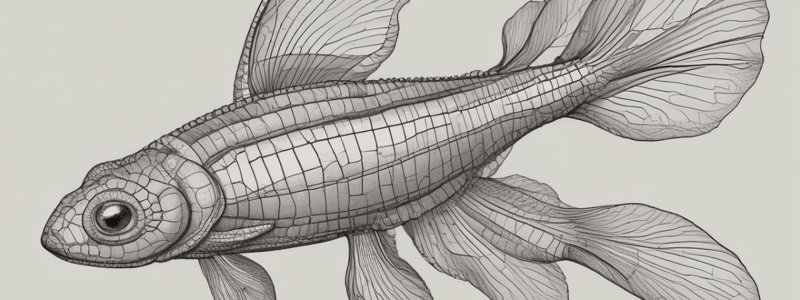Podcast
Questions and Answers
La multiplication asexuée permet une colonisation lente d'un milieu.
La multiplication asexuée permet une colonisation lente d'un milieu.
False (B)
Les cellules germinales sont issues de cellules souches.
Les cellules germinales sont issues de cellules souches.
True (A)
La mitose permet d'obtenir des ovules et des spermatozoïdes.
La mitose permet d'obtenir des ovules et des spermatozoïdes.
False (B)
La photopériode n'affecte pas la multiplication asexuée.
La photopériode n'affecte pas la multiplication asexuée.
La reproduction sexuée concerne la lignée germinale et la gamétogénèse.
La reproduction sexuée concerne la lignée germinale et la gamétogénèse.
Les cellules somatiques font partie des gonades.
Les cellules somatiques font partie des gonades.
La multiplication asexuée dépend de la reproduction sexuée.
La multiplication asexuée dépend de la reproduction sexuée.
La méiose permet d'obtenir des ovocytes et des spermatocytes.
La méiose permet d'obtenir des ovocytes et des spermatocytes.
La reproduction sexuée concerne la formation de spores.
La reproduction sexuée concerne la formation de spores.
Le cycle vital est la période de temps pendant laquelle se déroule la vie incomplète d’un organisme vivant.
Le cycle vital est la période de temps pendant laquelle se déroule la vie incomplète d’un organisme vivant.
Un individu mature est incapable de se reproduire.
Un individu mature est incapable de se reproduire.
La gastrulation est la première phase du développement d’un embryon.
La gastrulation est la première phase du développement d’un embryon.
La neurulation permet de positionner les tissus primordiaux dans l’espace.
La neurulation permet de positionner les tissus primordiaux dans l’espace.
La phase d’organogénèse a lieu avant la naissance de la larve.
La phase d’organogénèse a lieu avant la naissance de la larve.
La larve est directement en contact avec l’environnement pendant la phase d’organogénèse.
La larve est directement en contact avec l’environnement pendant la phase d’organogénèse.
La reproduction peut être asexuée.
La reproduction peut être asexuée.
Le zygote est le tout dernier stade de l’embryon.
Le zygote est le tout dernier stade de l’embryon.
La croissance postnatale permet d’obtenir l’état adulte de l’individu.
La croissance postnatale permet d’obtenir l’état adulte de l’individu.
Les auxocytes I entrent en prophase II de méiose pour se diviser en méiose I.
Les auxocytes I entrent en prophase II de méiose pour se diviser en méiose I.
La prophase I compte 4 étapes.
La prophase I compte 4 étapes.
Les chromosomes sont bichromatidiens au stade leptotène.
Les chromosomes sont bichromatidiens au stade leptotène.
Les bivalents sont formés à l'étape zygotène.
Les bivalents sont formés à l'étape zygotène.
L'enveloppe nucléaire disparaît au stade pachytène.
L'enveloppe nucléaire disparaît au stade pachytène.
La recombinaison génétique se produit au stade diplotène.
La recombinaison génétique se produit au stade diplotène.
Les chromatides non-sœurs restent en contact au niveau des chiasmas au stade diplotène.
Les chromatides non-sœurs restent en contact au niveau des chiasmas au stade diplotène.
Les chromosomes homologues s'écartent au stade zygotène.
Les chromosomes homologues s'écartent au stade zygotène.
Les auxocytes I deviennent diploïdes à la fin de la méiose I.
Les auxocytes I deviennent diploïdes à la fin de la méiose I.
L'épaississement des chromosomes par spiralisation est maximal pendant la prophase I.
L'épaississement des chromosomes par spiralisation est maximal pendant la prophase I.
Les centromères des bivalents sont attirés vers les pôles pendant la métaphase I.
Les centromères des bivalents sont attirés vers les pôles pendant la métaphase I.
Les chromosomes bichromatidiens sont recombinés pendant l'anaphase I.
Les chromosomes bichromatidiens sont recombinés pendant l'anaphase I.
La téléphase I se caractérise par la désorganisation du fuseau et la reformation de l'enveloppe nucléaire avec 2n chromosomes.
La téléphase I se caractérise par la désorganisation du fuseau et la reformation de l'enveloppe nucléaire avec 2n chromosomes.
La seule phase de synthèse a lieu pendant la télophase I.
La seule phase de synthèse a lieu pendant la télophase I.
La prophase II est inexistante pour certaines espèces.
La prophase II est inexistante pour certaines espèces.
Les 4 nouvelles cellules formées à la fin de la méiose II ont des chromosomes bichromatidiens.
Les 4 nouvelles cellules formées à la fin de la méiose II ont des chromosomes bichromatidiens.
Les extrémités des chromosomes se détachent de l'enveloppe nucléaire pendant la métaphase I.
Les extrémités des chromosomes se détachent de l'enveloppe nucléaire pendant la métaphase I.
La méiose II est la première division de la méiose.
La méiose II est la première division de la méiose.
La méiose produit 4 cellules diploïdes.
La méiose produit 4 cellules diploïdes.
La parthénogénèse nécessite des gamètes mâles et femelles.
La parthénogénèse nécessite des gamètes mâles et femelles.
Le gonochorisme est caractérisé par l'expression phénotypique du sexe déterminée environnementalement.
Le gonochorisme est caractérisé par l'expression phénotypique du sexe déterminée environnementalement.
La femelle XX est hétérogamétique.
La femelle XX est hétérogamétique.
Les apports combinés des chromosomes contenus dans les gamètes forment des spermatozoïdes.
Les apports combinés des chromosomes contenus dans les gamètes forment des spermatozoïdes.
L'hermaphrodisme correspond à la capacité d'autofécondation uniquement.
L'hermaphrodisme correspond à la capacité d'autofécondation uniquement.
L'hermaphrodisme simultané correspond à la capacité de changer de sexe au cours du cycle vital.
L'hermaphrodisme simultané correspond à la capacité de changer de sexe au cours du cycle vital.
L'hermaphrodisme successif est rencontré chez les oiseaux.
L'hermaphrodisme successif est rencontré chez les oiseaux.
La parthénogénèse est un processus rencontré chez les mammifères.
La parthénogénèse est un processus rencontré chez les mammifères.




